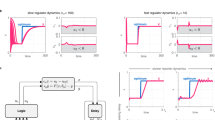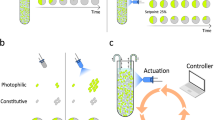Abstract
Synthetic biology is a useful tool to investigate the dynamics of small biological networks and to assess our capacity to predict their behavior from computational models. In this work we report the construction of three different synthetic networks in Escherichia coli based upon the incoherent feed-forward loop architecture. The steady state behavior of the networks was investigated experimentally and computationally under different mutational regimes in a population based assay. Our data shows that the three incoherent feed-forward networks, using three different macromolecular inhibitory elements, reproduce the behavior predicted from our computational model. We also demonstrate that specific biological motifs can be designed to generate similar behavior using different components. In addition we show how it is possible to tune the behavior of the networks in a predicable manner by applying suitable mutations to the inhibitory elements.









Similar content being viewed by others
Abbreviations
- EC:
-
Elongation complex
- FFL:
-
Feed-forward loop
- GFP:
-
Green fluorescent protein
- IPTG:
-
Isopropyl-β-d-thiogalactopyranoside
- LB:
-
Luria broth
- ORF:
-
Open reading frame
- PCR:
-
Polymerase chain reaction
- RBS:
-
Ribosome binding site
- T7-RNAP:
-
T7 RNA polymerase T7-RNAP
- SAM:
-
S-Adenosyl methionine
- SBW:
-
Systems biology workbench
- TE:
-
Translational efficiency
References
Ackers GK, Johnson AD, Shea MA (1982) Quantitative model for gene-regulation by lambda-phage repressor. Proc Natl Acad Sci USA Biol Sci 79:1129–1133
Basu S, Gerchman Y, Collins CH, Arnold FH, Weiss R (2005) A synthetic multicellular system for programmed pattern formation. Nature 434:1130–1134
Basu S, Mehreja R, Thiberge S, Chen MT, Weiss R (2004) Spatiotemporal control of gene expression with pulse-generating networks. Proc Natl Acad Sci USA 101:6355–6360
Belfaiza J, Parsot C, Martel A, Delatour CB, Margarita D, Cohen GN, Saintgirons I (1986) Evolution in biosynthetic pathways – 2 enzymes catalyzing consecutive steps in methionine biosynthesis originate from a common ancestor and possess a similar regulatory region. Proc Natl Acad Sci USA 83:867–871
Bray D (1995) Protein molecules as computational elements in living cells. Nature 376:307–312
Gottesman S (2004) The small RNA regulators of Escherichia coli: roles and mechanisms. Annu Rev Microbiol 58:303–328
Hartwell LH, Hopfield JJ, Leibler S, Murray AW (1999) From molecular to modular cell biology. Nature 402:C47–C52
Huang JB, Villemain J, Padilla R, Sousa R (1999) Mechanisms by which T7 lysozyme specifically regulates T7 RNA polymerase during different phases of transcription. J Mol Biol 293:457–475
Huerta AM, Collado-Vides J (2003) Sigma70 promoters in Escherichia coli: specific transcription in dense regions of overlapping promoter-like signals. J Mol Biol 333:261–278
Ishihara S, Fujimoto K, Shibata T (2005) Cross talking of network motifs in gene regulation that generates temporal pulses and spatial stripes. Genes Cells 10:1025–1038
Kaern M, Weiss R (2006) Synthetic gene regulatory systems. In: Szallasi Z, Stelling J, Periwal V (eds) System modeling in cellular biology from concepts to nuts and bolts, chap 13. MIT Press, pp 269–298
Kawano M, Reynolds AA, Miranda-Rios J, Storz G (2005) Detection of 5′- and 3′-UTR-derived small RNAs and cis-encoded antisense RNAs in Escherichia coli. Nucleic Acids Res 33:1040–1050
Kumar A, Patel SS (1997) Inhibition of T7 RNA polymerase: transcription initiation and transition from initiation to elongation are inhibited by T7 lysozyme via a ternary complex with RNA polymerase and promoter DNA. Biochemistry 36:13954–13962
Lee TI, Rinaldi NJ, Robert F, Odom DT, Bar-Joseph Z, Gerber GK, Hannett NM, Harbison CT, Thompson CM, Simon I et al (2002) Transcriptional regulatory networks in Saccharomyces cerevisiae. Science 298:799–804
Mangan S, Alon U (2003) Structure and function of the feed-forward loop network motif. Proc Natl Acad Sci USA 100:11980–11985
Mayya V, Loew LM (2005) STAT module can function as a biphasic amplitude filter. Syst Biol 2:43–52
Milo R, Shen-Orr S, Itzkovitz S, Kashtan N, Chklovskii D, Alon U (2002) Network motifs: Simple building blocks of complex networks. Science 298:824–827
Moffatt BA, Studier FW (1987) T7 Lysozyme inhibits transcription by T7 RNA-polymerase. Cell 49:221–227
Old IG, Phillips SEV, Stockley PG, Saintgirons I (1991) Regulation of methionine biosynthesis in the Enterobacteriaceae. Prog Biophys Mol Biol 56:145–185
Phillips SEV, Stockley PG (1996) Structure and function of Escherichia coli met repressor: similarities and contrasts with trp repressor. Phil Trans Roy Soc London B Biol Sci 351:527–535
Sauro HM, Kholodenko BN (2004) Quantitative analysis of signaling networks. Prog Biophys Mol Biol 86:5–43
Sauro HM, Hucka M, Finney A, Wellock C, Bolouri H, Doyle J, Kitano H (2003) Next generation simulation tools: the Systems Biology Workbench and BioSPICE integration. OMICS 7(4):355–372
Selinger DW, Cheung KJ, Mei R, Johansson EM, Richmond CS, Blattner FR, Lockhart DJ, Church GM (2000) RNA expression analysis using a 30 base pair resolution Escherichia coli genome array. Nat Biotechnol 18:1262–1268
Setty Y, Mayo AE, Surette MG, Alon U (2003) Detailed map of a cis-regulatory input function. Proc Natl Acad Sci USA 100:7702–7707
Shen-Orr SS, Milo R, Mangan S, Alon U (2002) Network motifs in the transcriptional regulation network of Escherichia coli. Nat Genet 31:64–68
Stano NM, Patel SS (2004) T7 lysozyme represses T7 RNA polymerase transcription by destabilizing the open complex during initiation. J Biol Chem 279:16136–16143
Storz G, Opdyke JA, Zhang AX (2004) Controlling mRNA stability and translation with small, noncoding RNAs. Curr Opin Microbiol 7:140–144
Storz G, Altuvia S, Wassarman KM (2005) An abundance of RNA regulators. Annu Rev Biochem 74:199–217
Villemain J, Sousa R (1998) Specificity in transcriptional regulation in the absence of specific DNA binding sites: the case of T7 lysozyme. J Mol Biol 281:793–802
Weissbach H, Brot N (1991) Microreview regulation of methionine synthesis in Escherichia coli. Mol Microbiol 5(7): 1693–1597
Wolf DM, Arkin AP (2003) Motifs, modules and games in bacteria. Curr Opin Microbiol 6:125–134
Zhang X, Studier FW (1997) Mechanism of inhibition of bacteriophage T7 RNA polymerase by T7 lysozyme. J Mol Biol 269:10–27
Acknowledgements
This work was supported by a grant from the National Science Foundation (Id 0432190). The GFP was kindly donated by Drew Endy form the Biobricks repository. We would also like to acknowledge useful discussions with Vijay Chickarmane.
Author information
Authors and Affiliations
Corresponding author
Additional information
Brian Aufderheide provided material support.
Rights and permissions
About this article
Cite this article
Entus, R., Aufderheide, B. & Sauro, H.M. Design and implementation of three incoherent feed-forward motif based biological concentration sensors. Syst Synth Biol 1, 119–128 (2007). https://doi.org/10.1007/s11693-007-9008-6
Received:
Revised:
Accepted:
Published:
Issue Date:
DOI: https://doi.org/10.1007/s11693-007-9008-6




